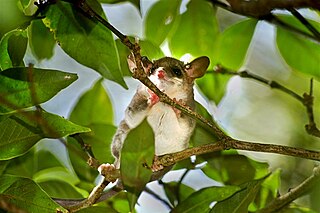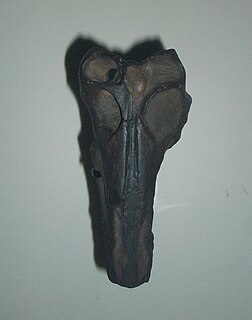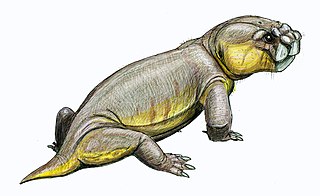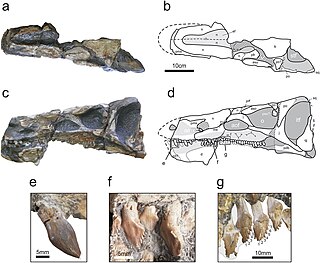
Dubreuillosaurus is a genus of carnivorous dinosaur from the middle Jurassic Period. It is a megalosaurid theropod. Its fossils were found in France. The only named species, Dubreuillosaurus valesdunensis, was originally described as a species of Poekilopleuron, Poekilopleuron? valesdunensis, which is still formally the type species of the genus. It was later renamed Dubreuillosaurus valesdunensis when, in 2005, Allain came to the conclusion that it was not part of the genus Poekilopleuron. Its type specimen, MNHN 1998-13, is only rivalled in the number of preserved elements in this group by that of Eustreptospondylus. Dubreuillosaurus is considered to be the sister species of Magnosaurus. It did not show signs of insular dwarfism even though it was uncovered on an island.

Shansisuchus is an extinct genus of archosauriform reptile belonging to the family Erythrosuchidae that lived during the Middle Triassic in what is now China. The first fossils of Shansisuchus were discovered from the Ermaying Formation of Shansi Province in 1964 by Chinese paleontologist Yang Zhongjian. Like other erythrosuchids, Shansisuchus was a large-bodied carnivore with a large, deep skull. Shansisuchus is unique among early archosauriforms in having a hole in its skull called a subnarial fenestra.

An antorbital fenestra is an opening in the skull that is in front of the eye sockets. This skull character is largely associated with archosaurs, first appearing during the Triassic Period. Among extant archosaurs, birds still possess antorbital fenestrae, whereas crocodylians have lost them. The loss in crocodylians is believed to be related to the structural needs of their skulls for the bite force and feeding behaviours that they employ. In some archosaur species, the opening has closed but its location is still marked by a depression, or fossa, on the surface of the skull called the antorbital fossa.

Marmosops is a genus of Neotropic opossums of the family Didelphidae. It includes the following species:

Parapsicephalus is a genus of long-tailed rhamphorhynchid pterosaurs from the Lower Jurassic Whitby, Yorkshire, England. It contains a single species, P. purdoni, named initially as a species of the related rhamphorhynchid Scaphognathus in 1888 but moved to its own genus in 1919 on account of a unique combination of characteristics. In particular, the top surface of the skull of Parapsicephalus is convex, which is otherwise only seen in dimorphodontians. This has been the basis of its referral to the Dimorphodontia by some researchers, but it is generally agreed upon that Parapsicephalus probably represents a rhamphorhynchid. Within the Rhamphorhynchidae, Parapsicephalus has been synonymized with the roughly contemporary Dorygnathus; this, however, is not likely given the many differences between the two taxa, including the aforementioned convex top surface of the skull. Parapsicephalus has been tentatively referred to the Rhamphorhynchinae subgrouping of rhamphorhynchids, but it may represent a basal member of the group instead.

Eremoryzomys polius, also known as the gray rice rat or the Marañon oryzomys, is a rodent species in the tribe Oryzomyini of the family Cricetidae. Discovered in 1912 and first described in 1913 by Wilfred Osgood, it was originally placed in Oryzomys and named Oryzomys polius. In 2006, a cladistic analysis found that it was not closely related to Oryzomys in the strict sense or to any other oryzomyine then known, so that it is now placed in its own genus, Eremoryzomys. The Brazilian genus Drymoreomys, named in 2011, is probably the closest relative of Eremoryzomys. Eremoryzomys has a limited distribution in the dry upper valley of the Marañón River in central Peru, but may yet contain more than one species.
Rautiania is an extinct genus of gliding neodiapsid reptiles belonging to the family Weigeltisauridae. Isolated fossil remains of Rautiania are known from the Late Permian of Russia. The genus is known from two species, Rautiania alexandri and Rautiania minichi, which differ in aspects of their maxilla and parietal bones. Certain Rautiania fossils have helped to reveal certain aspects of weigeltisaurid anatomy and lifestyle which had long alluded paleontologists, such as the component bones of the "crest" at the back of the head, and the large amount of adaptations towards life in the canopies of forests.

Eusthenodon is an extinct genus of prehistoric tristichopterids from the Late Devonian period, ranging between 383 and 359 million years ago. They are well known for being a cosmopolitan genus with remains being recovered from East Greenland, Australia, Central Russia, South Africa, and Belgium. Compared to the other closely related genera of the Tristichopteridae clade, Eusthenodon was one of the largest lobe-finned fishes and among the most derived tristichopterids alongside its close relatives Cabonnichthys and Mandageria.

Shenzhoupterus is a genus of chaoyangopterid azhdarchoid pterodactyloid pterosaur from the Lower Cretaceous Jiufotang Formation of Liaoning, China.

Psilopterus is an extinct genus of phorusrhacid from the Middle Oligocene to Late Pleistocene of Argentina and Uruguay. Compared to other phorusrhacids, members of the genus are both relatively gracile and diminutive, and include the smallest known species of terror bird: with the head raised P. bachmanni was 70–80 centimeters (2.3–2.6 ft) in height and weighed about 5 kilograms (11 lb), while the largest members of the genus were only about 7 kilograms (15 lb). The birds resemble the modern cariama, except with a heavier build and considerably smaller wings. The strong morphological similarity between the claws of the predatory cariama and Psilopterus, both of which are sharp, curved, and laterally compressed, may indicate they were used to strike prey. In contrast to the other, larger terror birds, Tonni and Tambussi also suggested Psilopterus could use their claws to climb trees, and could even fly, but this has been rejected in more recent literature. Fossil finds in Uruguay indicate the genus may have survived until 96,040 ± 6,300 years ago, millions of years after the larger phorusrhacids became extinct.

Pelanomodon is an extinct genus of dicynodont therapsids that lived in the Late Permian period. Fossil evidence of this genus is principally found in the Karoo Basin of South Africa, in the Dicynodon Assemblage Zone. Lack of fossil record after the Late Permian epoch suggests that Pelanomodon fell victim to the Permian-Triassic extinction event.
Wanosuchus is an extinct genus of sebecosuchian mesoeucrocodylian known from ?Paleocene-age rocks of southern Anhui, China. It is based on IVPP V 6262, a nearly complete lower jaw, which is also the only known specimen. The bone lacks an external mandibular fenestra and has thirteen teeth, the longest of which are the fourth and eleventh. It was collected between 1970 and 1972 by Institute of Vertebrate Paleontology and Paleoanthropology (IVPP) personnel; the exact location and rock unit that produced the bone are uncertain. Wanosuchus was named in 1981 by Zhang Fakui of the IVPP. The type species is W. atresus, a reference to the absent fenestra. Zhang classified Wanosuchus under its own family within Sebecosuchia, Wanosuchidae. It shares some characteristics with Doratodon, a crocodyliform from the Late Cretaceous of Europe.

Youngosuchus is an extinct genus of archosauriform from the Middle Triassic of China. The type species is Y. sinensis. Y. sinensis was first described in 1973 as a new species of the erythrosuchid Vjushkovia. In 1985, it was reassigned as its own genus of rauisuchid. A 1992 study supported the original classification of Youngosuchus sinensis as an erythrosuchid, but more recent studies classify it as a "rauisuchian"-grade loricatan archosaur completely unrelated to Vjushkovia, which is most likely a synonym of Garjainia.

Zhuchengtyrannus is a genus of tyrannosaurid theropod dinosaur known from the Late Cretaceous period of Shandong Province, China. It belongs to the tyrannosaurinae subfamily, and contains a single species, Zhuchengtyrannus magnus.
Centenariosuchus is an extinct genus of caimanine crocodylian known from the Miocene of the Panama Canal Zone of Panama. It contains a single species, Centenariosuchus gilmorei, that was named in 2013 in honor of the upcoming centennial anniversary of the digging of the Panama Canal. Two fossil specimens consisting of skull fragments were found in the Early to Middle Miocene Cucaracha Formation in 2009 and 2011, and may belong to a single individual. The species is diagnosed by a combination of skull features that it shares with basal caimans like Tsoabichi, Eocaiman, Culebrasuchus, and the living genus Paleosuchus, as well as more derived caimans such as those in the genus Caiman. One feature that distinguishes Centenariosuchus from all other caimans is the straight outer margin of a hole on the underside of the skull called the suborbital fenestra. According to one phylogenetic analysis of caimanine relationships, Centenariosuchus falls within a clade or evolutionary grouping of caimans that includes the very large and highly specialized forms Purussaurus and Mourasuchus, known from the Miocene of South America.

Brachydeirus is a genus of small to moderately large-sized arthrodire placoderms from the Late Devonian of Europe, restricted to the Kellwasserkalk Fauna of Bad Wildungen and Adorf.

Longusunguis is an extinct genus of bohaiornithid enantiornithean dinosaur known from the Early Cretaceous of Liaoning Province, northeastern China. It contains a single species, Longusunguis kurochkini.

Khunnuchelys was a genus of trionychine turtle from the Late Cretaceous of Asia. Three species are known, K. erinhotensis, the type species, K. kizylkumensis, and K. lophorhothon. K. erinhotensis lived in China from the late Turonian until the middle Campanian. K. kizylkumensis existed during the late Turonian of Uzbekistan. The third species, described in 2013 by Danilov et al., persisted from the early to middle Campanian of Kazakhstan.

Isaberrysaura is a genus of ornithischian dinosaur from the Early Jurassic Los Molles Formation of Patagonia, Argentina. The genus contains a single species, I. mollensis, described by Salgado et al. in 2017 from a single specimen. Although initially classified as a basal neornithischian, subsequent analysis has allied it with the Stegosauria; the morphology of its skull resembles those of other members of the group.
Shuangbaisaurus is genus of theropod dinosaur, possibly a junior synonym of Sinosaurus. It lived in the Early Jurassic of Yunnan Province, China, and is represented by a single species, S. anlongbaoensis, known from a partial skull. Like the theropods Dilophosaurus and Sinosaurus,Shuangbaisaurus bore a pair of thin, midline crests on its skull. Unusually, these crests extended backwards over the level of the eyes, which, along with the unusual orientation of the jugal bone, led the describers to name it as a new genus. However, Shuangbaisaurus also possesses a groove between its premaxilla and maxilla, a characteristic which has been used to characterize Sinosaurus as a genus. Among the two morphotypes present within the genus Sinosaurus, Shuangbaisaurus more closely resembles the morphotype that is variably treated as a distinct species, S. sinensis, in its relatively tall skull.















